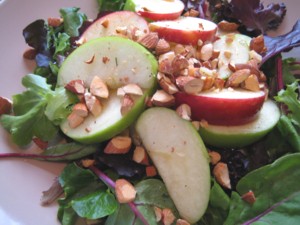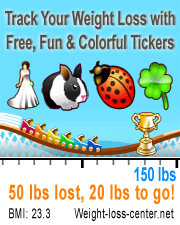My salads for lunch consist of the following basics:
4 cups of mixed salad greens
1 tomato, diced
3 baby carrots, diced
2 tablespoons of low-fat or fat-free salad dressing
To keep it interesting I will also usually add either half a can of tuna, a chopped hard-boiled egg, grapefruit wedges, or a few other vegetables. Mmmm, good.
Here’s a picture of todays salad. Mixed greens with apple slices topped with chopped, toasted almonds, all dressed with a honey and balsamic vinaigrette… DELICIOUS!

I was chatting with one of my co-workers around the water cooler this morning and I was telling her about how I’m on a diet. She’s a bit of a skinny minny… one of those people who is always thin and doesn’t seem to gain a pound (mind you I’ve never seen her eat anything either). Anyway, she said to me, “Oh, I just hate diets because you can’t eat anything and your always so hungry.” I agreed with her, probably just to shorten the conversation, but when I got back to my desk I regretted not correcting her. The assumption that dieting means being hungry all the time is a common one, but I have found from my own experiences that this isn’t necessarily true.
The way I see dieting is that I have to reduce the number of calories I eat each day, but this doesn’t mean I have to eat less and in some cases I will actually eat more. Take for instance my salad, which I am starting to struggle finishing because I’m getting full. On average my salad at lunch contains between 400 and 500 calories. This is equivalent to a McDonalds cheeseburger, a couple slices of pizza, or a KFC chicken breast (all things I shamefully admit to eating during my last “diet”). But I tell you, none of these meals would fill me up. I’d be starving before I was even finished eating. But this salad, my god, it’s never ending.
The basic diet concept of all this is called Volumetrics. This just goes to show that dieting doesn’t mean you have to go hungry, just make smarter food choices. Sounds easy, doesn’t it?





Leave a Reply